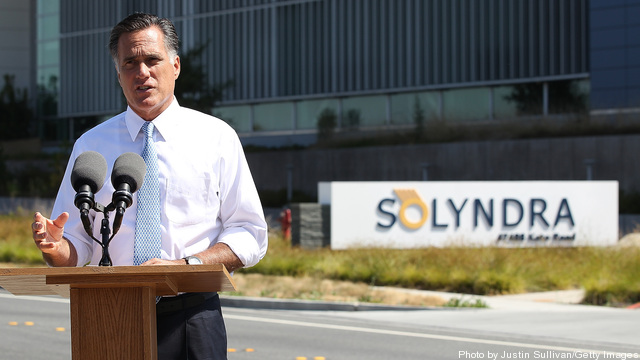
Questions about the efficacy of President Barack Obama’s stimulus spending for clean-energy programs came under the spotlight on Thursday with the claim by Republican presidential nominee Mitt Romney that “half” of the companies that received government support under the $90 billion program had gone out of business.
Romney attacked the program that poured billions into clean energy as part of the administration’s effort to keep the economy afloat after the 2008 financial meltdown, saying that the money could have been better spent on teachers, and accusing the president of picking “losers.”
“You put $90 billion into – into green jobs,” Romney said during the first presidential debate on Wednesday evening. “And these businesses – many of them have gone out of business. I think about half of them, of the ones have been invested in, they’ve gone out of business.”
As an example, Romney cited the bankrupt solar panel maker Solyndra, the best-known recipient of federal clean-energy funds, that went out of business after receiving federal loan guarantees of $535 million.
Environmentalists including the NRDC Action Fund attacked Romney’s assertion that half of the subsidized companies had gone out of business, saying that U.S. Department of Energy figures show only 1.4 percent of those companies have failed.
Heather Taylor, director of the advocacy affiliate of the environmental group Natural Resources Defense Council, rejected Romney’s claim that half of the companies that received stimulus funds have gone out of business.
Which Years are We Talking About?
“The number cited by Romney is complete fiction – a handful of companies granted loan guarantees have folded – but hundreds of other companies are succeeding,” she said.
“To say that half the investments failed because of two years of the loan guarantee is like declaring the world series winner based on who got a hit in the second inning of game two.”
A spokeswoman for the Romney campaign said the former Massachusetts governor had been referring specifically to the 1705 loan-guarantee program, which funded seven companies, including Solyndra, in its first two years, 2009 and 2010.
Of those companies, three have gone bankrupt and a fourth is on the verge of failure, the spokeswoman wrote in an email.
Only the companies that received subsidies in 2009 and 2010 were included in the analysis that led to Mr. Romney’s statement, the spokeswoman said.
Another 19 received total or partial loan guarantees ranging from $97 million to $1.46 billion in 2011. Those were excluded from the Romney analysis because it was too early to say whether they had viable business plans, she said.
“Saying that a company that received a loan guarantee a year ago has not failed yet is pretty much meaningless,” said the spokeswoman. “If you look at the loans that went out during the first two years of the program … and have had a chance to succeed or fail, half have failed.”
In addition to Solyndra, the failed companies are Beacon Power, a Massachusetts energy-storage business that received a $43 million loan from the Energy Department and filed for bankruptcy in October 2011, and Abound Solar, a solar manufacturer that filed for bankruptcy in mid-2012 after receiving $400 million in federal loan guarantees.
Nevada Geothermal Power, a fourth recipient of federal clean-energy subsidies in 2009-10, is on the verge of failure after receiving $145 million in federal money, according to the Romney campaign.
The Romney campaign, echoing the candidate’s remarks in the debate, also accused the Obama administration of providing stimulus funds to clean-energy firms that supported the Democratic party.
The campaign cited a Washington Post editorial claiming that 71 percent of the Obama Energy Department’s grants and loans went to “individuals who were bundlers, members of Obama’s National Finance Committee, or large donors to the Democratic Party” who collectively raised more than $450,000 for the President’s re-election campaign and were approved for grants or loans of nearly $11.35 billion.
Bill Gibbons, a spokesman for the DOE, referred questions stemming from the presidential debate to the party campaigns.
According to the White House, the major components of clean-energy stimulus funding were $29 billion for energy efficiency; $21 billion for renewable energy generation; $18 billion for high-speed rail, and $10 billion on smart-grid improvements to electricity transmission infrastructure.
